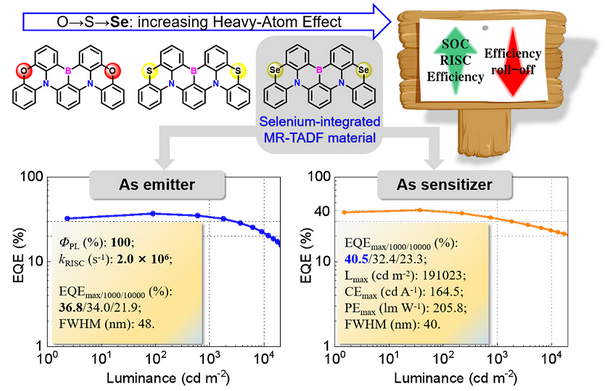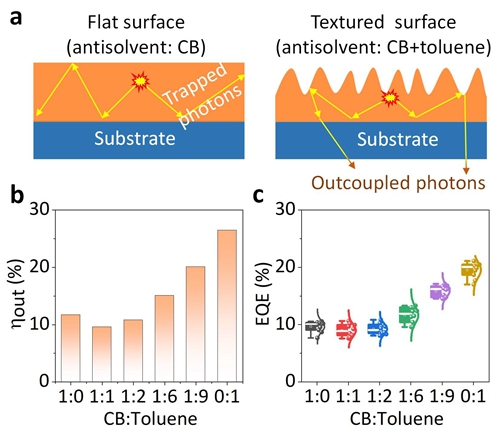With the development of LED display, more and more technologies and application of LED display have been discovered.
Here I want to talk some new technologies of LED display. We can learn the trends of LED display from these new technologies. This will help us make better decisions.
A major breakthrough has been made in the field of narrow-spectrum OLED research
On October 14, Nature Photonics published online the latest achievements of the team of Professor Yang Chuluo of Shenzhen University in the field of OLED research.
Thermally Activated Delayed Fluorescence (TADF) materials have become a research hotspot in organic light-emitting diode (OLED) light-emitting materials in the past decade due to their ability to achieve a theoretical 100% internal quantum efficiency. In recent years, multiple resonance thermally activated delayed fluorescence (MR-TADF) materials have great application potential in high-definition displays due to their narrow-band emission characteristics.
However, the reverse intersystem jumping rate (kRISC) of multiple resonance TADF materials is generally slow, resulting in a sharp attenuation of the efficiency of light-emitting devices at high brightness, which makes it difficult for the corresponding OLED devices to have both high efficiency and high color purity. and low roll-off. In order to solve the key problem of the efficiency roll-off, the team of Professor Yang Chuluo of Shenzhen University synthesized BNSeSe by embedding non-metallic heavy atom selenium element into the multiple resonance framework, and used the heavy atom effect to enhance the coupling between the single and triplet (S1 and T1) orbitals of the material. , resulting in extremely high kRISC (2.0 × 106 s-1) and photoluminescence quantum efficiency (100%).

The external quantum efficiency of the vapor-deposited OLED device prepared by using BNSeSe as the guest material of the light-emitting layer is as high as 36.8%, and its efficiency roll-off is effectively suppressed. The external quantum efficiency is still as high as 21.9% at m-² brightness, which is comparable to phosphorescent materials such as iridium and platinum. In addition, for the first time, they fabricated superfluorescent OLED devices using multiple resonance-type TADF materials as sensitizers. Transparent LED devices. The device has a maximum external quantum efficiency of 40.5% and an external quantum efficiency of 32.4% at 1000 cd m-² brightness. Even at 10,000 cd m-² brightness, the external quantum efficiency is still as high as 23.3%, the maximum power efficiency exceeds 200 lm W-1, and the maximum brightness is close to 200,000 cd m-².
This work provides a new idea and an effective way to solve the efficiency roll-off problem of MR-TADF electroluminescent devices, which has great application prospects in high-definition display. The related results were published in the internationally renowned journal Nature Photonics under the title of "Efficient selenium-integrated TADF OLEDs with reduced roll-off" ("Nature Photonics", impact factor 39.728, JCR District 1 of the Chinese Academy of Sciences, ranking first in the field of optics).
USTC has made important progress in the field of perovskite LED and light-emitting device research
Perovskite materials have important application prospects in the fields of solar cells, LEDs, and photodetectors due to their excellent optoelectronic properties. The film formation quality and microstructure of perovskite films play a crucial role in the performance of optoelectronic devices. The nanostructure formed on the surface of the perovskite increases the scattering of photons on the surface of the thin film, achieving a breakthrough in the efficiency limit of perovskite LED devices. The related results were published in Advanced Materials under the title "Overcoming the Outcoupling Limit of Perovskite Light-emitting Diodes with Artificially Formed Nanostructures".

Perovskite LEDs have the advantages of tunable emission wavelength, narrow emission half-peak width, and easy preparation. The device efficiency of perovskite LEDs is currently mainly limited by the light extraction efficiency. Therefore, increasing the light extraction efficiency of the device is a very important research direction. In organic LEDs and quantum dot LEDs, additional light extraction layers are generally required to increase photon extraction, such as the use of fly-eye lens arrays, biomimetic moth-eye nanostructures, and low-refractive-index coupling layers. However, these methods make the device fabrication process more complicated and increase the manufacturing cost.
Xiao Zhengguo's research group reported a method that can spontaneously form a textured structure on the surface of perovskite thin films,and improve the light extraction efficiency of perovskite
LEDs by increasing the photon scattering on the surface of the thin film. During the film preparation, by controlling the residence time of the anti-solvent on the film surface, the crystallization process of perovskite can be controlled, resulting in a textured surface. For films with an average thickness of 1.5 μm, the surface roughness can be continuously controlled from 15.3 nm to 241 nm, and the haze is correspondingly increased from 6% to more than 90%.
Benefiting from the increase in photon scattering on the film surface, the light extraction efficiency of perovskite LEDs with textured structures increased from 11.7% to 26.5% of planar perovskite LEDs, and the corresponding device efficiency of perovskite LEDs also increased from 10%. % increased significantly to 20.5%. The above work provides a new method to fabricate light-extracting nanostructures for perovskite optoelectronic devices. The perovskite film with micro-nano structure is similar to the textured morphology in crystalline silicon solar cells, which is expected to improve the light absorption efficiency and performance of perovskite solar cells.
Post time: Nov-07-2022
